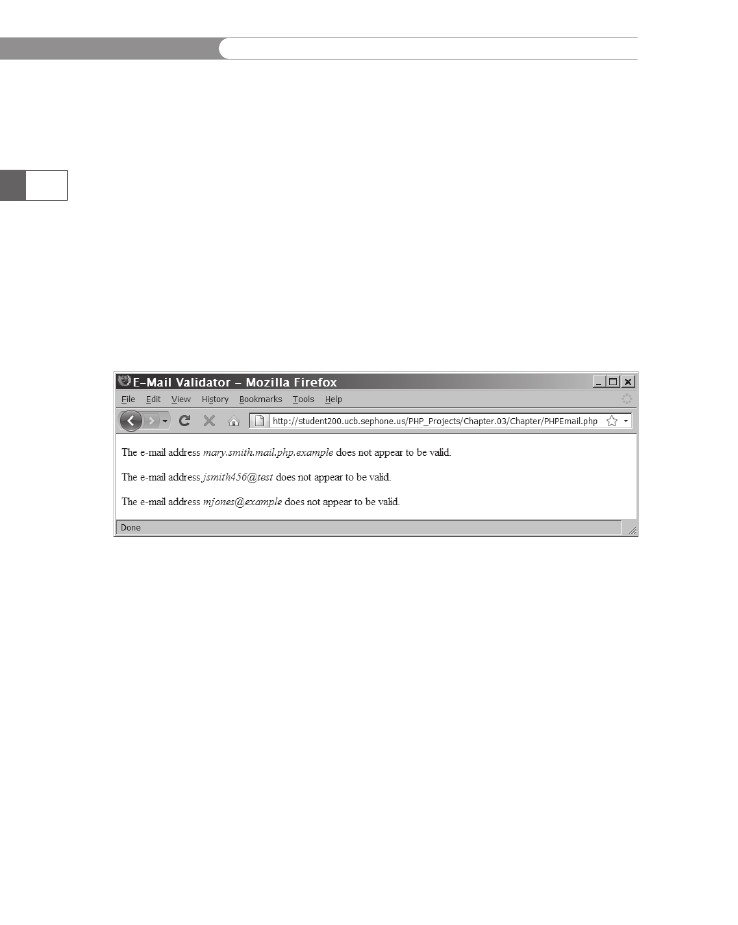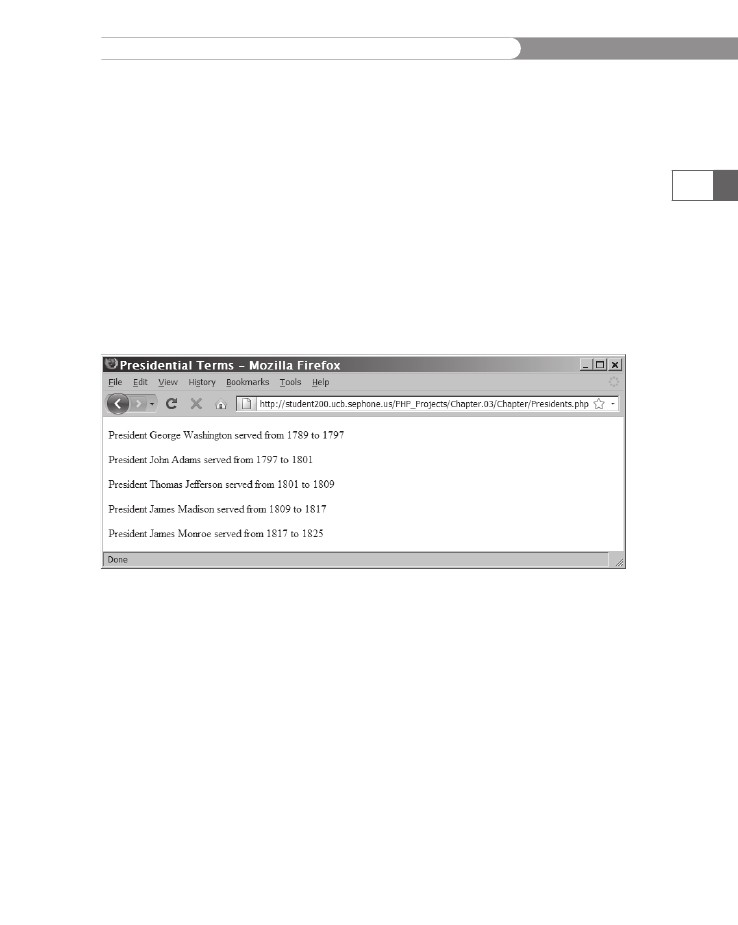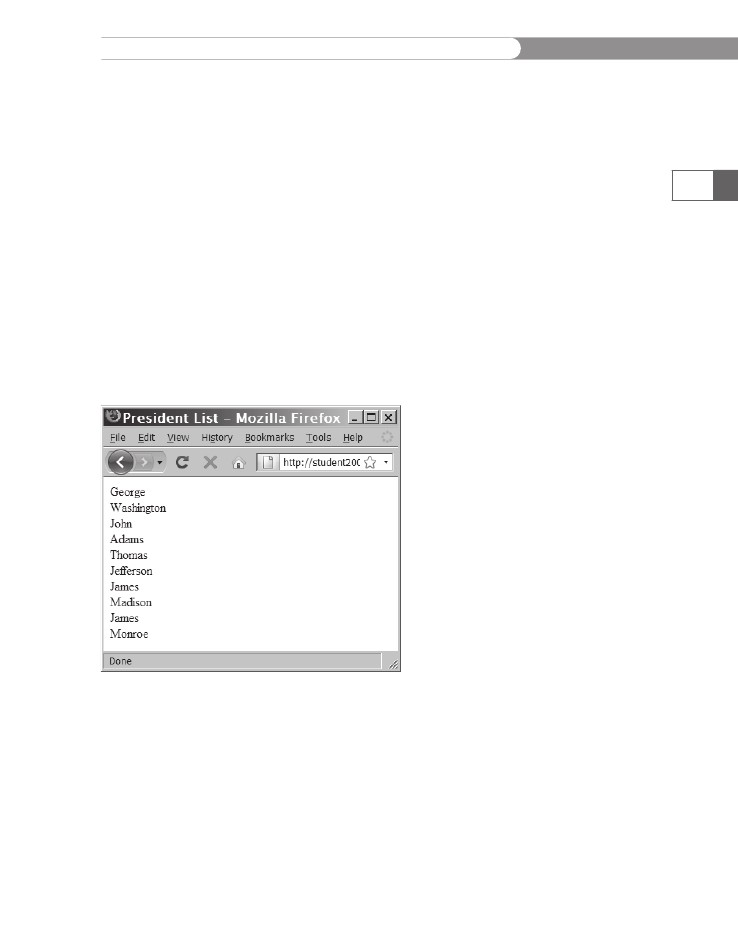
- •Initializing with Constructor Functions . . . . .
- •Into a Web page as a separate section. Although JavaScript code can
- •Is that standard php script delimiters are guaranteed to be available
- •In the block. Any text or lines between the opening /* characters and
- •2.7541 Are not integers; they are floating-point numbers. A floating-
- •Value 300
- •Is a value of 2.5, because 6 goes into 15 exactly 2.5 times. But if you
- •IsEven.Php.
- •Ing example,
- •Ing curly brace is on its own line following the function statements.
- •In php 3 and earlier, it was necessary to put a function definition
- •Is called an iteration. When the conditional expression evaluates
- •Including Files
- •13. Close your Web browser window.
- •Including Files
- •In php, you can also use two operators to combine strings. The first
- •Xhtml source code gen-
- •Input. Php provides several functions for manipulating the case of a
- •Is uppercase. If you need the reverse of ucfirst(), the lcfirst()
- •In some situations, you will need to find and extract characters and
- •Information Interchange, or ascii, which are numeric represen-
- •In comparison, the following preg_match() function returns a value
- •In the pattern is optional. The following code demonstrates how to
- •Values; any strings you validate against a regular expression must
- •Value of 1 because the top-level domain contains a valid value of .Com.
- •Is submitted using the “post” method, the form data is embedded in
- •Validating String Data
- •Xhtml tags or character entities. The message field is a text string
- •Value of the header element. For example:
- •Xhtml code within a php script section.
- •Is typically the person who created the resource. Otherwise, the net-
- •If even a single character of the Web page is sent prior to sending
- •Variables to the file_put_contents() function.
- •Xhtml hyperlink. To download a file from outside the xhtml
- •If...Else statement to display the appropriate version of the mes-
- •Iterating Through an Array
- •Iterating Through an Array
- •In Chapter 2, you learned how to use a foreach statement to iterate
- •Iterating Through an Array
- •Iterating Through an Array
- •In comparison, the following code declares and initializes
- •If ((!file_exists("MessageBoard/messages.Txt"))
- •Values from the array to create a thumbnail gallery of images in which
- •Introduction to Databases
- •Including php, allow you to create Web pages that can read and write
- •Introduction to Databases
- •Information that can be organized into ordered sets of data, and
- •Information. Each recipe in a recipe database, for instance, is a single
- •Introduction to Databases
- •Index, which identifies records in a database to make retrievals and
- •In a single table. However, you might want to break the information
- •Into multiple tables to better organize it into logical sets. Another
- •Information in one of the tables confidential and accessible only by
- •Is the employee information table from Figure 7-1. The related table
- •Is a payroll table that contains confidential salary and compensation
- •Information. Notice that each table contains an identical number of
- •Introduction to Databases
- •Introduction to Databases
- •In a junction
- •Introduction to Databases
- •In a relational format is called a relational database management
- •Is a standard data manipulation language among many dbmSs.
- •Into the query area at the top of the screen or by dragging tables and
- •It is important to understand that even though many dbmSs sup-
- •Introduction to Databases
- •If you ever
- •Is. In comparison, the bigint data type stores integer values between
- •5 Rows in set (0.00 sec)
- •Int);[enter ]
- •Important, these two tabs can cause you to lose all of the data in the
- •Internet Explorer to export the table, click the Save button in the File
- •Ifies the table being changed and the change to make.
- •It easier for you to write php code that can be used with a variety of
- •Information about queries that match one of the following formats:
- •Various types of actions, depending on the type of query.
- •Include fields for the date and time of the flight, flight number, and
- •In the ChineseZodiac folder and upload the file to the server. Open
- •Including white space,
- •Information on a Web server. When you start a new session, the
- •Introduction to Object-Oriented Programming
- •Introduction to Object-Oriented
- •Variables associated with an object are called properties or attributes.
- •In the Loan object example, a function that calculates the number of
- •Introduction to Object-Oriented Programming
- •Introduction to Object-Oriented Programming
- •Include instances of objects inherit the object’s functionality.
- •In this chapter, you will create the Web site for an online order form
- •In an online store application. The application includes information
- •Ity of building a working online store. Online store classes are very
- •Information and products. The OnlineStore class requires that store
- •Information is stored in a table containing six fields: storeId, name,
- •Information. Instead, the class simply uses session iDs to keep track
- •Variable and function as necessary, without bothering with all this
- •In a class
- •Is developed. Imagine what would happen if Microsoft distributed
- •Ing class is invalid because it does not include an access specifier:
- •If they will not be supported by future xhtml versions or are not
- •Xhtml standards. To review the guide of current w3c css specifi-
- •Information to remind yourself or others of what the code is doing. A
- •Xhtml document to the external style sheet. This link informa-
- •If you select Apache from the WampServer menu and select Service
- •Ing code uses the number_format() function to add comma separa-
- •In data that a user submits to a php script.
- •Value of “On” and the display_startup_errors directive is assigned
- •Instead. By looking at the source code, you could see that the value of
- •Ing engine can even help locate logic errors.
- •In Chapter 8, along with the equivalent mssql_* functions, where
- •Inline styles, 632
- •Xhtml, 620–635 (continued)
Working
with Multiple Strings
Short
Quiz
1.
What
string function would you use to determine the number
of
characters in a password that a user has entered?
What
string function would you use to determine if an essay
keyed
in a <textarea>
form
input field exceeds the maximum
number
of words allowed?
What
two string functions could be used to convert the case
of
text strings to all uppercase or all lowercase letters?
141
2.
3.
Working
with Multiple Strings
PHP
provides many functions for splitting a string into substrings,
merging
multiple strings, and changing one string based on another.
In
this section, you will study basic techniques for working with more
than
one string.
Finding
and Extracting Characters
and
Substrings
When
applied to text strings, the term parsing
refers
to the act of
dividing
a string into logical component substrings or tokens. This is
essentially
the same process as the parsing (rendering) that occurs in
a
Web browser when it extracts the necessary formatting informa-
tion
from a Web page before displaying it on the screen. In the case
of
a Web page, the document itself is one large text string from which
formatting
and other information needs to be extracted. However, at
a
programming level, parsing usually refers to the extraction of
infor-
mation
from string literals and variables.
substrings
from a string. For example, if your script receives an e-mail
address,
you may need to extract the name portion of the e-mail
address
or domain name. Several functions in PHP allow you to find
and
extract characters and substrings from a string.
There
are two types of string search and extraction functions: func-
tions
that return a numeric position in a text string and those that
return
a character or substring. Both functions return a value of
FALSE
if
the search string is not found. To use functions that return
the
numeric position in a text string, you need to understand thatIn some situations, you will need to find and extract characters and

CHAPTER
3
Manipulating
Strings
142
the
position of characters in a text string begins with a value of 0,
the
same as with indexed array elements. For example, the strpos()
function
performs a case-sensitive search and returns the position of
the
first occurrence of a substring within a string. You pass two argu-
ments
to the strpos()
function:
The first argument is the string you
want
to search, and the second argument contains the substring for
which
you want to search. If the search substring is not found, the
strpos()
function
returns a Boolean value of FALSE.
The following
code
uses the strpos()
function
to determine whether the $Email
variable
contains an @ character. Because the position of text strings
begins
with 0, the echo
statement
returns a value of 9, even though
the
@ character is the 10th character in the string.
$Email
= "president@whitehouse.gov";
echo
strpos($Email, '@'); // returns 9
If
you simply want to determine whether a character exists in a string,
you
need to keep in mind that PHP converts the Boolean values TRUE
and
FALSE
to
1 and 0, respectively. However, these values are char-
acter
positions within a string. For example, the following statement
returns
a value of 0 because “p” is the first character in the string:
$Email
= "president@whitehouse.gov";
echo
strpos($Email, 'p'); // returns 0
To
determine whether the strpos()
function
(and other string func-
tions)
actually returns a Boolean FALSE
value
and not a 0 representing
the
first character in a string, you must use the strict equal operator
(===)
or the strict not equal operator (!==).
The following example
uses
the strpos()
function
and the strict not equal operator to deter-
mine
whether the $Email
variable
contains an @ character:
You
first
encountered
the
strict not
equal
operator
in
Chapter
1.
$Email
= "president@whitehouse.gov";
if
(strpos($Email, '@') !== FALSE)
echo
"<p>The e-mail address contains an @ character.</p>";
else
echo "<p>The e-mail address does not contain an @
character.</p>";
Because
the e-mail
address in
the $Email
variable in this
example only contains a
single period, you can
use either the strchr()
or strrchr() function.
To return the last portion of a string, starting with a specified char-
acter, you use strchr() or strrchr(). You pass to both functions
the string and the character for which you want to search. Both
functions return a substring from the specified characters to the end
of the string. The only difference between the two functions is that
the strchr() function starts searching at the beginning of a string,
whereas the strrchr() function starts searching at the end of a
string. The following code uses the strrchr() function to return the
top-level domain (TLD) of the e-mail address in the $Email variable:
$Email = "president@whitehouse.gov";
echo "<p>The top-level domain of the e-mail address is "
. strrchr($Email, ".") . ".</p>";
Working
with Multiple Strings
To
use the strpos()
function
to check whether e-mail addresses con-
tain
ampersands and a period to separate the domain name from the
top-level
domain:
1.
2.
Create
a new document in your text editor.
Type
the <!DOCTYPE>
declaration,
<html>
element,
document
head,
and <body>
element.
Use the strict DTD and “E-Mail
Validator”
as the content of the <title>
element.
Add
the following script section to the document body:
<?php
?>
143
3.
4.
Declare
an array called $EmailAddresses.
Populate the list
with
several valid and invalid e-mail addresses. The following
code
provides a good starting point, but you may add more
addresses.
$EmailAddresses
= array(
"john.smith@php.test",
"mary.smith.mail.php.example",
"john.jones@php.invalid",
"alan.smithee@test",
"jsmith456@example.com",
"jsmith456@test",
"mjones@example",
"mjones@example.net",
"jane.a.doe@example.org");
The three top-level domains .test, .example, and .invalid,
as well as the three domains example.com, example.net, and
example.org, are special names that will never connect to a
real server.
5.
Add the following function to the beginning of the script
section, immediately after the declaration statement for the
$EmailAddresses array. The function uses two strpos()
functions to determine whether the string passed to it con-
tains an ampersand and a period. If the string contains both
characters, a value of TRUE is returned. If not, a value of FALSE
is returned.
function validateAddress($Address) {
if (strpos($Address, '@') !== FALSE &&
strpos($Address,
'.') !== FALSE)
return TRUE;
else
return FALSE;
}

CHAPTER
3
Manipulating
Strings
6.
Add
the following foreach
statement
immediately after
the
validateAddress
function
declaration. The if
con-
ditional
expression passes the $Address
variable
to the
validateAddress()
function.
If the function returns a value
of
FALSE,
the echo
statement
executes.
foreach
($EmailAddresses as $Address) {
if
(validateAddress($Address) == FALSE)
echo "<p>The e-mail address <em>$Address</em>
does not appear to be valid.</p>\n";
}
144
7.
Save the file as PHPEmail.php, upload it to the server, and
then open the file in your Web browser by entering the
following URL:
http://<yourserver>/PHP_Projects/Chapter.03/Chapter/
PHPEmail.php. The output for the preceding addresses is
shown in Figure 3-12.
Figure 3-12
Output of the E-Mail Validator script
8.
Close your Web browser window.
Replacing Characters and Substrings
In addition to finding and extracting characters in a string, you might
need to replace them. PHP provides a number of functions to replace
text within a string, including str_replace(), str_ireplace(), and
substr_replace().
The str_replace() and str_ireplace() functions both accept three
arguments: the string you want to search for, a replacement string,
and the string in which you want to replace characters. The replace-
ment functions do not modify the contents of an existing string.
Instead, they return a new string, which you can assign to a variable,
use in an echo statement, or use in your script in some other way. The
Working
with Multiple Strings
following
example demonstrates how to use the str_replace()
func-
tion
to replace “president” in the $Email
variable
with “vice.president”.
$Email
= "president@whitehouse.gov";
$NewEmail
= str_replace("president", "vice.president",
$Email);
echo
$NewEmail;
//
displays 'vice.president@whitehouse.gov'
145
Instead of replacing all occurrences of characters within a string, the
substr_replace() function allows you to replace characters within
a specified portion of a string. You pass to the substr_replace()
function the string you want to search, the replacement text, and the
starting and ending positions of the characters you want to replace.
If you do not include the last argument, the substr_replace() func-
tion replaces all the characters from the starting position to the end
of the string. For example, the following code uses the strpos() and
substr_replace() functions to replace “president” in the $Email
variable with “vice.president.”
$Email = "president@whitehouse.gov";
$NameEnd = strpos($Email, "@");
$NewEmail = substr_replace($Email, "vice.president", 0,
$NameEnd);
echo $NewEmail;
// displays 'vice.president@whitehouse.gov'
The following code demonstrates how to use the substr_replace()
function to replace text from one string when storing the value in a
new variable. The code uses the strpos() and strrpos() functions
to locate the starting and ending positions of the word “Medical” in
“American Medical Association”. The
substr_replace() functionthen replaces the word “Medical” with the word “Heart”, changing the
name to “American Heart Association” when storing the value in the
new location. Figure 3-13 shows the results.
$FirstStudyPublisher = "American Medical Association";
$MiddleTermStart = strpos($FirstStudyPublisher, " ") + 1;
$MiddleTermEnd = strrpos($FirstStudyPublisher, " ") -
$MiddleTermStart;
$SecondStudyPublisher = substr_
replace($FirstStudyPublisher, "Heart",
$MiddleTermStart, $MiddleTermEnd);
echo "<p>The first study was published by the
$FirstStudyPublisher.</p>\n";
echo "<p> The second study was published by the
$SecondStudyPublisher.</p>\n";

CHAPTER
3
Manipulating
Strings
146
Figure
3-13
Output
of the Study Publisher script
To
use the str_replace()
function
to display a list of American pres-
idents
and their terms in office:
1.
2.
Create
a new document in your text editor.
Type
the <!DOCTYPE>
declaration,
<html>
element,
document
head,
and <body>
element.
Use the strict DTD and “Presiden-
tial
Terms” as the content of the <title>
element.
Add
the following script section to the document body:
<?php
?>
3.
4.
Declare
an array called $Presidents.
Populate the list with
the
names of the first five presidents, as follows:
$Presidents
= array(
"George
Washington",
"John Adams",
"Thomas Jefferson",
"James Madison",
"James Monroe");
5.
Declare an array called $YearsInOffice. Populate the list
with the terms of the first five presidents, as follows:
$YearsInOffice = array(
"1789 to 1797",
"1797 to 1801",
"1801 to 1809",
"1809 to 1817",
"1817 to 1825");
6.
Declare a template string for the output as follows:
$OutputTemplate = "<p>President [NAME] served from
[TERM]</p>\n";

Working
with Multiple Strings
7.
Add
the following foreach
loop
to retrieve each president
and
create an output string from the template string:
foreach
($Presidents as $Sequence => $Name) {
$TempString
= str_replace("[NAME]", $Name,
$OutputTemplate);
$OutputString = str_replace("[TERM]",
$YearsInOffice[$Sequence],
$TempString);
echo $OutputString;
}
147
8.
Save the file as Presidents.php, upload it to the server,
and then open the file in your Web browser by entering the
following URL:
http://<yourserver>/PHP_Projects/Chapter.03/Chapter/
Presidents.php. Figure 3-14 shows the output.
Figure 3-14
9.
Output of the Presidents.php script
Close your Web browser window.
Dividing Strings into Smaller Pieces
If you receive a text string that contains multiple data elements sepa-
rated by a common delimiter, you will probably want to split the
string into its individual elements. A delimiter is a character or string
that is used to separate components in a list. The delimiter is usu-
ally not found in any of the elements. For example, you may receive
a list of names, separated by commas. Although you could use some
of the string functions you’ve seen so far to manually parse such a
string into smaller pieces, you can save yourself a lot of work by using
the strtok() function to break a string into smaller strings, called
tokens. When it is first called, the syntax for the strtok() function

CHAPTER
3
Manipulating
Strings
148
If
you spec-
ify an empty
string as the
second argu-
ment of the
strtok() function, or if
the string does not con-
tain any of the separators
you specify, the
strtok() function
returns the entire string.
is $variable = strtok(string, separators);. The strtok()
function assigns to $variable the token (substring) from the begin-
ning of the string to the first separator. To assign the next token to
$variable, you call the strtok() function again, but only pass to
it a single argument containing the separator. The PHP scripting
engine keeps track of the current token and assigns the next token
to $variable, starting at the first character after the separator, each
time the strtok() function is called and until the end of the string is
reached. If there are no characters between two separators, between
the start of the string and the first separator, or between the last sepa-
rator and the end of the string, strtok() returns an empty string.
The first statement in the following code assigns the names of the
first five American presidents to the $Presidents variable, sepa-
rated by semicolons. The first strtok() function assigns the first
token (George Washington) to the $President variable. The while
statement then displays the token and assigns the next token to the
$President variable. The while loop iterates through the tokens until
the $President variable is equal to NULL. Figure 3-15 shows the
output.
$Presidents = "George Washington;John Adams;Thomas
Jefferson;James Madison;James Monroe";
$President = strtok($Presidents, ";");
while ($President != NULL) {
echo "$President<br />";
$President = strtok(";");
}
Figure 3-15
Using strtok() to divide a list using semicolons

Working
with Multiple Strings
The
strtok()
function
does not divide a string into tokens by using
a
substring that is passed as its second argument. Instead, it divides
a
string into tokens using any of the characters that are passed in
the
second argument. For example, if you include a semicolon and
a
space (“; ”) in the second argument for the strtok()
function,
the
string
is split into tokens at each semicolon or space in the string. The
following
example contains a modified version of the preceding code.
In
this version, the separators
arguments
passed to the strtok()
functions
contain a semicolon and a space. For this reason, the string
is
split into tokens at each semicolon and individual space in the
$Presidents
variable,
as shown in Figure 3-16.
$Presidents
= "George Washington;John Adams;Thomas
Jefferson;James
Madison;James Monroe";
$President
= strtok($Presidents, "; ");
while
($President != NULL) {
echo
"$President<br />";
$President = strtok("; ");
}
149
Figure 3-16 Using strtok() to divide a list using
semicolons and spaces
To look for empty fields in a UNIX password file record using the
strtok() function:
1.
2.
Create a new document in your text editor.
Type the <!DOCTYPE> declaration, <html> element, document
head, and <body> element. Use the strict DTD and “Password
Fields” as the content of the <title> element.
CHAPTER
3
Manipulating
Strings
3.
Add
the following script section to the document body:
<?php
?>
4.
150
5.
Declare
and initialize a string called $Record,
as follows:
$Record
= "jdoe:8W4dS03a39Yk2:1463:24:John
Doe:/home/jdoe:/bin/bash";
Declare
an array called $PasswordFields,
as follows:
$PasswordFields
= array(
"login
name",
"optional encrypted password",
"numerical user ID",
"numerical group ID",
"user name or comment field",
"user home directory",
"optional user command interpreter");
6.
Enter the following code to tokenize the string and display a
message for each missing field:
$FieldIndex = 0;
$ExtraFields = 0;
$CurrField = strtok($Record, ":");
while ($CurrField != NULL) {
if ($FieldIndex < count($PasswordFields))
echo "<p>The
{$PasswordFields[$FieldIndex]} is
<em>$CurrField</em></p>\n";
else {
++$ExtraFields;
echo "<p>Extra field # $ExtraFields is
<em>$CurrField</em></p>\n";
}
$CurrField = strtok(":");
++$FieldIndex;
}
7.
Save the file as PasswordFields.php, upload it to the server,
and then open the file in your Web browser by entering the
following URL:
http://<yourserver>/PHP_Projects/Chapter.03/Chapter/
PasswordFields.php. Figure 3-17 shows the output.

Working
with Multiple Strings
151
Figure
3-17
8.
Using
strtok()
to
parse a password record
Close
your Web browser window.
Converting
between Strings and Arrays
In
addition to splitting a string into tokens, you can split a string
into
an
array, in which each array element contains a portion of the string.
In
most cases, you will probably find it more useful to split a string
into
an array instead of tokens because you have more control over
each
array element. With strings that are split with the strtok()
function,
you can only work with a substring if it is the current token.
Although
tokenizing a string is useful if you want to quickly display or
iterate
through the tokens in a string, you need to assign the tokens
to
another variable or array if you want to modify the tokens in any
way.
By contrast, when you split a string into an array, portions of the
string
are automatically assigned to elements.
You
use the str_split()
or
explode()
function
to split a string
into
an indexed array. The str_split()
function
splits each
character
in a string into an array element, using the syntax
$array
= str_split(string[, length]);.
The length
argument
represents
the number of characters you want assigned to each array
element.
The explode()
function
splits a string into an indexed array
at
a specified separator. The syntax for the explode()
function
is
$array
= explode(separator, string);.
Be sure to notice that the
order
of the arguments for the explode()
function
is the reverse of
CHAPTER
3
Manipulating
Strings
the
arguments for the strtok()
function.
The following code dem-
onstrates
how to split the $Presidents
string
into an array named
$PresidentArray:
$Presidents
= "George Washington;John Adams;Thomas
Jefferson;James
Madison;James Monroe";
$PresidentArray
= explode(";", $Presidents);
foreach
($PresidentArray as $President) {
echo
"$President<br />";
}
152
If you pass
to the
explode()
function an
empty string
as the separator argu-
ment, the function returns
a Boolean value of
FALSE.
If the string does not contain the specified separator, the entire string
is assigned to the first element of the array. Also, unlike the strtok()
function, the explode() function does not separate a string at any
character that is included in the separator argument. Instead, the
explode() function evaluates the characters in the separator argu-
ment as a substring. For example, a semicolon and a space separate
each president’s name in the following code. Therefore, you pass “; ”
as the separator argument of the explode() function.
$Presidents = "George Washington; John Adams; Thomas
Jefferson; James Madison; James Monroe";
$PresidentArray = explode("; ", $Presidents);
foreach ($PresidentArray as $President) {
echo "$President<br />";
}
The opposite of the explode() function is the implode() function,
which combines an array’s elements into a single string, separated
by specified characters. The syntax for the implode() function
is $variable = implode(separator, array);. The following
example first creates an array named $PresidentsArray, then uses
the implode() function to combine the array elements into the
$Presidents variable, separated by a comma and a space. Figure 3-18
shows the output.
$PresidentsArray = array("George Washington", "John
Adams", "Thomas Jefferson", "James Madison", "James
Monroe");
$Presidents = implode(", ", $PresidentsArray);
echo $Presidents;
Figure 3-18
Using implode() to build a string from an array

Working
with Multiple Strings
To
modify PasswordFields.php so the record is split into an array
instead
of tokens:
1.
2.
Return
to the PasswordFields.php script in your text editor.
Replace
the declaration and initialization of $CurrField
with
the
following statement:
$Fields
= explode(":",$Record);
153
3.
Replace
the while
loop
with a foreach
loop
as follows:
foreach
($Fields as $FieldIndex => $FieldValue) {
if
($FieldIndex < count($PasswordFields))
echo "<p>The
{$PasswordFields[$FieldIndex]} is
<em>$FieldValue</em></p>\n";
else {
++$ExtraFields;
echo "<p>Extra field # $ExtraFields is
<em>$FieldValue</em></p>\n";
}
}
4.
Save the PasswordFields.php file, upload it to the server, and
then open the file in your Web browser by entering the fol-
lowing URL: http://<yourserver>/PHP_Projects/Chapter.03/
Chapter/ PasswordFields.php. The output should still look like
Figure 3-17.
Close your Web browser window.
5.
Short Quiz
1.
What function can be used to determine if a specific charac-
ter exists in a string?
What is the difference between the str_replace() function
and the str_ireplace() function?
What functions are used to split a string into an indexed
array?
2.
3.

CHAPTER
3
Manipulating
Strings
Comparing
Strings
In
Chapter 1, you studied various operators that you can use with
PHP,
including comparison operators. Although comparison opera-
tors
are most often used with numbers, they can also be used with
strings.
The following statement uses the comparison operator (==)
to
compare two variables containing text strings:
$Florida
= "Miami is in Florida.";
$Cuba
= "Havana is in Cuba.";
if
($Florida == $Cuba)
echo
"<p>Same location.</p>";
else
echo "<p>Different location.</p>";
154
Because the text strings are not the same, the else clause displays
the text “Different location.” You can also use comparison operators
to determine whether one letter occurs later in the alphabet than
another letter. In the following code, the first echo statement executes
because the letter “B” occurs later in the alphabet than the letter “A”:
$FirstLetter = "A";
$SecondLetter = "B";
if ($SecondLetter > $FirstLetter)
echo "<p>The second letter occurs later in the alphabet
than the first letter.</p>";
else
echo "<p>The second letter occurs earlier in the alphabet
than the first letter.</p>";
You use the
ord() func-
tion to
return the
ASCII value
of a character, and the
chr() function to return
the character for an
ASCII value.
